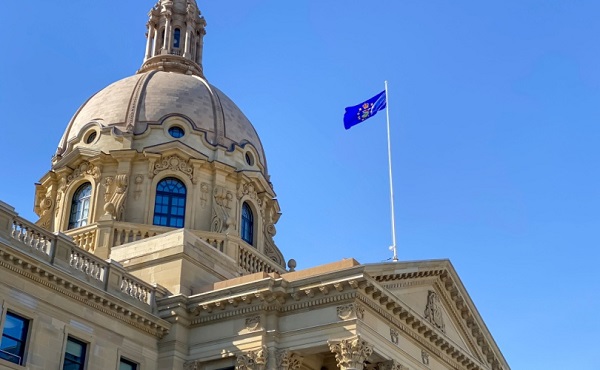Business
President Trump Ending ‘Catastrophic’ Loophole Blamed For Funneling Drugs, Harming US Workers


From the Daily Caller News Foundation
The Trump administration is ending a longstanding tax exemption on low-value packages, a move White House officials say will create jobs, raise revenue and even save lives.
By early Friday morning, tariff exemptions for packages shipped to the United States worth $800 or less, popularly known as the “de minimis” rule, will come to an end for all countries, senior administration officials said. The move comes months after President Donald Trump signed an executive order to end the de minimis exemption for China and Hong Kong.
The White House fiercely defended the action during a Thursday press call, framing it as defense against the flow of drugs and the protection of American workers.
As a nonprofit, we are dependent on the generosity of our readers.
Please consider making a small donation of any amount here.
Thank you!
“Foreign post offices need to get their act together when it comes to monitoring and policing the use of international mail for smuggling and tariff evasion purposes,” Navarro added. “We are going to help them do that, but at this point, they are vastly underperforming express carriers like FedEx, DHL and UPS. In an age of AI, information saves lives.”
Established by Congress in 1938, the de minimis exemption has, for decades, allowed low-value packages to enter the U.S. duty free. The exemption threshold has risen over the years, with the last change in 2016 including products valued at or below $800.
The vast majority of shipped products fall within the exemption, with more than 92% of all cargo entering the U.S. entering via de minimis, according to Customs and Border Protection.
In April, Trump signed an executive order formally ending the de minimis exemption for China and Hong Kong. Shippers from the People’s Republic of China, the president said, hide “illicit substances” and “conceal the true contents of shipments” sent to the U.S. and avoid detection due to the de minimis exemption.
An executive order Trump signed in late July set the stage for the exemption to end for all countries by Aug. 29. In an accompanying fact sheet for the July order, the White House referred to the de minimis exemption as a “catastrophic loophole” used to evade tariffs, funnel deadly synthetic opioids and inundate the country with unsafe or below-market products that negatively affect businesses.
“The minimum loophole was one of the dumbest things this country ever did,” Navarro said Thursday. “If you do your homework, you look around the rest of the world, and nobody comes even close to the $800 de minimis standard. There’s other countries, they’re five bucks, 10 bucks.”
Not everything will be affected by the change. Personal gifts worth under $100 and letters remain under the exemption, senior administration officials said.
Business
Canadians can’t afford another Ottawa budget failure

This article supplied by Troy Media.
A $92 billion budget deficit looms. Canadians need more than promises this time
As Ottawa prepares its fall budget, Canadians should demand a clean break from the status quo. After a decade of unrestrained deficit spending, we are fiscally adrift: burdened by costly new programs and a bloated bureaucracy, and with little to show for it.
That’s why the Carney government must do more than tinker and finally deliver the kind of budget Canadians haven’t seen in years.
The previous Liberal government left office with a national debt nearing $1.4 trillion, having failed to balance the budget in its nine years in power. A growing share of tax dollars is now going just to service that debt.
While the government has pledged to reduce program spending by 15 per cent in the 2028-29 fiscal year through shrinking departments and cutting waste (after smaller reductions the previous two years), it is still on track to post a sizeable deficit of $92 billion for 2025-26, according to projections published by the C.D. Howe Institute. That should be a warning sign. Ottawa cannot rely on vague promises of restraint years down the road—it needs to act now.
Here is what the Carney government must do to get its finances in order:
1. It needs to roll back costly programs and reduce the size of government.
Under Justin Trudeau, the federal bureaucracy grew by nearly 100,000 people, a 38 per cent increase. Yet despite a considerable hike in personnel costs, Canadians would be hard pressed to point to noticeable improvements in service delivery.
Real reform would look like the Chrétien model from the 1990s. Faced with persistent deficits, the Chrétien government acted decisively, cutting over 42,000 public sector jobs. A comparable 17.4 per cent reduction today could eliminate 64,000 jobs and save almost $10 billion annually.
The review should also cover new programs that depend on deficit spending and often overlap with provincial responsibilities.
For example, the federal dental plan is projected to cost taxpayers $13 billion over five years, while the proposed pharmacare plan will cost $13.4 billion per year by 2027-28. Rolling back such initiatives could yield substantial savings.
2. The government must remove excessive regulation that is strangling Canadian business.
Between 2006 and 2021, federal regulations increased by 37 per cent, reaching 320,000 in total. Statistics Canada estimates that this reduced real GDP growth by 1.7 percentage points, employment growth by 1.3 percentage points, and labour productivity growth by 0.4 percentage points over the same time period. Those numbers may seem abstract, but the effect is concrete: less growth, fewer jobs, lower productivity.
Canadian businesses spend about 768 million hours a year on compliance—the equivalent of 394,000 full-time jobs. In 2024 alone, red tape cost businesses nearly $51.5 billion—a hidden tax on productivity.
Is anyone surprised that entrepreneurship in Canada is on the decline? In the year 2000, three out of every 1,000 Canadians had started a business. By 2022, that rate had fallen to just 1.3 per 1,000, representing a nearly 57 per cent drop.
Had Ottawa maintained 2006 regulation levels, Canada would have seen a 10 per cent higher rate of new businesses entering the market in 2021.
3. The Carney government must scrap harmful policies that undermine our energy sector.
Regulations aimed squarely at Canada’s oil and gas sector are setting the country up for a rude awakening.
Take Ottawa’s oil and gas emissions cap, set to take effect next year. It aims to reduce emissions from this sector to 35 per cent below 2019 levels, but reports from Deloitte and the Parliamentary Budget Officer (PBO) confirm that it is effectively a production cap.
Oil and gas accounts for 3.3 per cent of national GDP in 2024, but the emissions cap would change that. Deloitte estimates that by 2040, this regulation would lower Canada’s GDP by one per cent, representing a $34.5-billion loss in constant 2017 dollars.
The cap would also cost 112,900 Canadian jobs by 2040. The numbers all point in the same direction: the policy is an economic self-inflicted wound.
Similarly, the PBO projects that to meet Ottawa’s emissions goal, oil and gas production would need to be 4.9 per cent lower than current forecasts over 2030-32.
For a country with the world’s fourth-largest natural gas reserves and as the third-largest exporter, such policies are reckless. This fall, Canadians should not be presented with a budget that doubles down on the same policies that have already strangled business creation, driven away investment and suppressed living standards.
Canadians are long overdue for something we haven’t seen in years—a responsible budget.
Samantha Dagres is Communications Manager at the Montreal Economic Institute, an independent think tank with offices in Montreal, Ottawa, and Calgary.
Troy Media empowers Canadian community news outlets by providing independent, insightful analysis and commentary. Our mission is to support local media in helping Canadians stay informed and engaged by delivering reliable content that strengthens community connections and deepens understanding across the country
Alberta
Alberta’s fiscal update—and $6.5 billion deficit—underscores need for spending reductions

From the Fraser Institute
By Tegan Hill
According to the Q1 fiscal update, the Alberta provincial government will run a $6.5 billion budget deficit this fiscal year—up from the $5.2 billion budget deficit projected in the February budget. This may come as a surprise to many on the heels of a $8.3 billion surplus in 2024/25, but it’s all part of Alberta’s ongoing resource revenue rollercoaster. And it’s time to get off the track.
Resource revenues, including oil and gas revenues, are inherently volatile. For perspective, over roughly the last decade, resource revenue has been as low as $2.8 billion in 2015/16, accounting for just 6.5 per cent of total revenue, and as high as $25.2 billion in 2022/23, accounting for 33.2 per cent of total revenue.
Alberta has a long history of enjoying budget surpluses when resource revenue is high, but inevitably falls back into deficits when resource revenue declines. And it’s no surprise we’re back here today.
According to the recent fiscal update, resource revenue will fall by $6.3 billion this year compared to last. That means that of the $14.8 billion swing in Alberta’s budget balance, nearly 43 per cent can be explained by a decline in resource revenue alone. And if resource revenue was the same level as last year, Alberta’s budget would nearly be balanced.
Deficits have real consequences. Consider Alberta’s last period of deficits, which went on nearly uninterrupted from 2008/09 to 2020/21. Alberta moved from a position of having more assets, such as the Heritage Fund, than it did debt, resulting in a net debt position of $59.5 billion in 2020/21. Overall, Alberta’s net financial position deteriorated by $94.6 billion over the period. Correspondingly, Albertans went from having interest payments on provincial debt of approximately $58 per person in 2008/09 to $564 in 2020/21 (that number is expected to surpass $705 per person by 2027/28).
Fortunately, Alberta isn’t doomed to the boom and bust cycle.
The key is understanding that Alberta’s fiscal challenges are not actually a revenue problem—they’re a spending problem. Indeed, the underlying issue is that governments typically increase spending during good times of relatively high resource revenue to levels that are unsustainable (without incurring deficits) when resource revenue inevitably declines. Put simply, ongoing spending levels significantly exceed stable ongoing revenue.
The provincial government has made important strides in recent years by limiting spending growth to inflation and population growth. Unfortunately, spending levels were already so misaligned with stable, predictable revenue, that it is simply not sufficient to avoid deficits. Alberta needs meaningful spending reductions.
Fortunately, there’s some low hanging fruit to help get the province on track. For instance, Alberta spends billion of dollars annually dolling out subsidies to select businesses and industries. For perspective, in 2024/25, grants were the largest expense for the ministry of environment and the second largest expense for the ministry of technology and innovation. The provincial government should require that each ministry closely examine their budgets and eliminate business subsidies to yield savings.
According to the recent fiscal update, Alberta will continue to ride the resource revenue rollercoaster in 2025/26. It’s time to finally change course. That means meaningful spending reductions—and eliminating business subsidies is a good place to start.
-

 Business2 days ago
Business2 days agoMounties, Overstretched and Overmatched by Foreign Mafias, No Longer Fit for Service
-

 Crime2 days ago
Crime2 days agoHigh-Profile PRC Fentanyl Financier Evades U.S. Extradition in Mexico City Tunnel Escape
-

 Business1 day ago
Business1 day agoB.C. Lottery Corp Fined $1M in First Casino Laundering Case Since Cullen Report
-

 Housing2 days ago
Housing2 days agoPBO Refuses to Model Liberal Housing Promise
-

 Business1 day ago
Business1 day agoAll of B.C. now subject to ‘Aboriginal title’ claims
-

 Alberta1 day ago
Alberta1 day agoAlberta deficit projected to hit 6.5 billion – up 1.3 billion after first quarter
-

 Business1 day ago
Business1 day agoCarney’s tariff blunder cost you at the checkout
-

 Business2 days ago
Business2 days agoCracker Barrel and the Power of Conservative Boycotts








